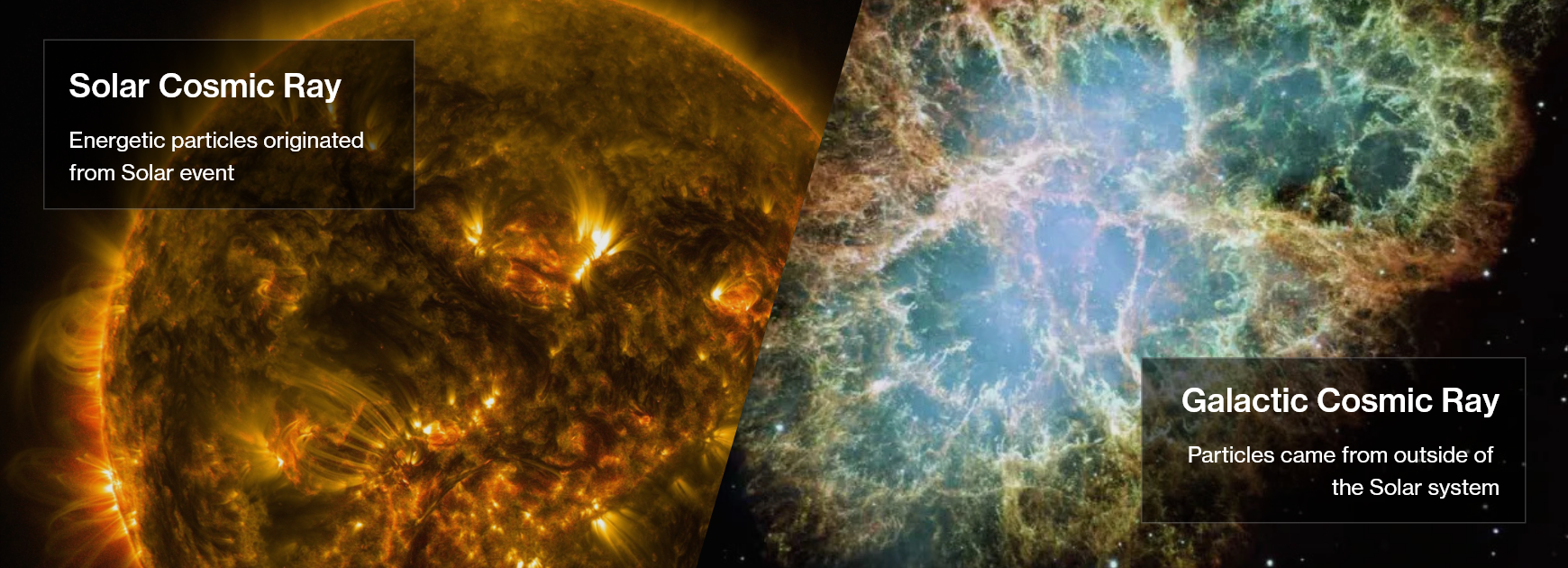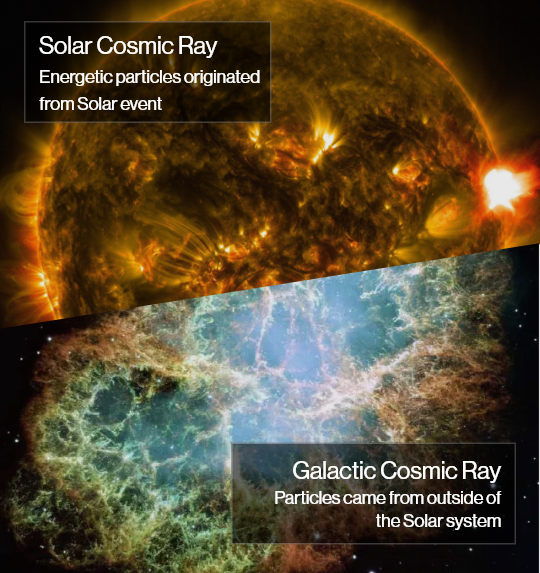Space Radiation
Space Radiation
Cosmic Radiation


Cosmic radiation is a collective term for high-energy primary cosmic radiation generated from the Sun and outside the solar system and came to the Earth, and secondary cosmic radiation that is generated by colliding with atoms constituting the atmosphere and reaching the Earth's surface.
The existence of cosmic radiation was first discovered in 1912 by hot-air balloon experiment carried by the Austrian scientist Victor Francis Hess using an electrometer to determine the ionization rate. Through the experiment, it was found that the ionization rate increased as the altitude increased, and this became the origin of radiation by suggesting its origin is from space.
Cosmic radiation is largely divided into galactic cosmic rays originating outside the solar system and solar cosmic rays originating from solar activity. Galactic Cosmic Rays (GCRs) are known to be generated outside the solar system by supernova remnants (SNRs), Active Galactic Nuclei (AGNs) and neutron stars. These are high-energy particles composed mainly of charged particles. Galactic cosmic rays composed of these charged particles may interact with space observation equipment and electronic equipment and interfere with the thier stable operation as they flow into the Earth, and may affect the health of the spacecraft crew and pose a risk to long-term missions.
Through long-term cosmic rays observation, it was confirmed that the flux of galactic cosmic rays is changed by the magnetic field in the Heliosphere. Galactic cosmic rays entering the Heliosphere are affected by magnetic fields and solar activity within the Heliosphere. As its getting approach the solar maximum of the solar cycle, solar activity such as solar flare and coronal mass ejection (CME)increases, the number of sunspots increases, and the magnetic field in the Heliosphere becomes stronger, so the effect of the magnetic field is increased. This reduces the amount of flux of galactic cosmic rays entering the Earth. As its getting approach the solar minimum, the solar activity decreases and the shielding effect by the magnetic field in the Heliosphere weakens, resulting in an increase in the amount of galactic cosmic rays entering the Earth. As such, the flux of galactic cosmic rays has a tendency opposite to the 11-year change in sunspot number due to solar activity.
On the other hands, solar cosmic rays are caused by the sudden release of high-energy particles from the Sun, such as solar flares or coronal mass ejections (CMEs). In addition, there are temporary changes detected by the spacecraft neutron detector, such as a phenomenon in which the flux of a spacecraft abruptly increases under the influence of the solar wind generated when the solar magnetic field is ejected into the Heliosphere by a solar explosion or a phenomenon in which the flux of the spacecraft abruptly decreases.
The high-energy particles that make up the primary cosmic rays are affected by the Earth's magnetic field as they enter the Earth's atmosphere. Low-energy primary cosmic rays are shielded by the Earth's magnetic field and cannot enter. In the case of the Earth's poles, the blocking effect by the Earth's magnetic field is small, so low-energy galactic cosmic rays are also incident and collide with the particles in the Earth's atmosphere. Cutoff rigidity is used as an index indicating the blocking effect of the Earth's magnetic field on the primary cosmic rays entering the Earth. This blocking effect uses the unit similar to the energy, GV. If the energy of particles entering the Earth is higher than the blocking cutoff rigidity, they may enter the Earth.
As the primary cosmic rays flow into the Earth through above process, they collide and react with oxygen, nitrogen, and argon that consist the Earth's atmosphere. During this process, secondary cosmic rays such as pions, muons, electrons, protons, neutrons and photons with energies of several hundred MeV or higher are produced. As a result, these secondary cosmic rays affect our daily life as a radiation source.
The existence of cosmic radiation was first discovered in 1912 by hot-air balloon experiment carried by the Austrian scientist Victor Francis Hess using an electrometer to determine the ionization rate. Through the experiment, it was found that the ionization rate increased as the altitude increased, and this became the origin of radiation by suggesting its origin is from space.
Cosmic radiation is largely divided into galactic cosmic rays originating outside the solar system and solar cosmic rays originating from solar activity. Galactic Cosmic Rays (GCRs) are known to be generated outside the solar system by supernova remnants (SNRs), Active Galactic Nuclei (AGNs) and neutron stars. These are high-energy particles composed mainly of charged particles. Galactic cosmic rays composed of these charged particles may interact with space observation equipment and electronic equipment and interfere with the thier stable operation as they flow into the Earth, and may affect the health of the spacecraft crew and pose a risk to long-term missions.
Through long-term cosmic rays observation, it was confirmed that the flux of galactic cosmic rays is changed by the magnetic field in the Heliosphere. Galactic cosmic rays entering the Heliosphere are affected by magnetic fields and solar activity within the Heliosphere. As its getting approach the solar maximum of the solar cycle, solar activity such as solar flare and coronal mass ejection (CME)increases, the number of sunspots increases, and the magnetic field in the Heliosphere becomes stronger, so the effect of the magnetic field is increased. This reduces the amount of flux of galactic cosmic rays entering the Earth. As its getting approach the solar minimum, the solar activity decreases and the shielding effect by the magnetic field in the Heliosphere weakens, resulting in an increase in the amount of galactic cosmic rays entering the Earth. As such, the flux of galactic cosmic rays has a tendency opposite to the 11-year change in sunspot number due to solar activity.
On the other hands, solar cosmic rays are caused by the sudden release of high-energy particles from the Sun, such as solar flares or coronal mass ejections (CMEs). In addition, there are temporary changes detected by the spacecraft neutron detector, such as a phenomenon in which the flux of a spacecraft abruptly increases under the influence of the solar wind generated when the solar magnetic field is ejected into the Heliosphere by a solar explosion or a phenomenon in which the flux of the spacecraft abruptly decreases.
The high-energy particles that make up the primary cosmic rays are affected by the Earth's magnetic field as they enter the Earth's atmosphere. Low-energy primary cosmic rays are shielded by the Earth's magnetic field and cannot enter. In the case of the Earth's poles, the blocking effect by the Earth's magnetic field is small, so low-energy galactic cosmic rays are also incident and collide with the particles in the Earth's atmosphere. Cutoff rigidity is used as an index indicating the blocking effect of the Earth's magnetic field on the primary cosmic rays entering the Earth. This blocking effect uses the unit similar to the energy, GV. If the energy of particles entering the Earth is higher than the blocking cutoff rigidity, they may enter the Earth.
As the primary cosmic rays flow into the Earth through above process, they collide and react with oxygen, nitrogen, and argon that consist the Earth's atmosphere. During this process, secondary cosmic rays such as pions, muons, electrons, protons, neutrons and photons with energies of several hundred MeV or higher are produced. As a result, these secondary cosmic rays affect our daily life as a radiation source.